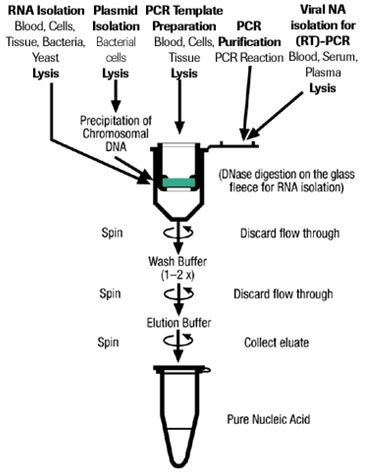High Pure Technology and Silica Adsorption Kits
The High Pure and silica adsorption kits developed by Roche depend on the tendency of nucleic acids to adsorb to silica (glass) in the presence of a chaotropic salt such as sodium iodide (NaI), guanidine thiocyanate or guanidine hydrochloride [Melzak et al. (1996), J. Colloid Interface Sci. (USA) 181, 635-644]. This tendency was discovered by Vogelstein and Gillespie [Vogelstein, B. and Gillespie, D. (1979), Proc. Natl. Acad. Sci. USA 76, 615-619] who found that DNA fragments adsorbed to powdered flint glass in the presence of saturated NaI. Later work revealed that other nucleic acids adsorbed to glass in the presence of other chaotropes.
Different types of nucleic acid adsorb more or less tightly to glass depending on the ionic strength and the pH of the surrounding solution. A low salt buffer or water is used to elute the nucleic acid from the glass. In each kit, this method is optimized to prepare a particular type of nucleic acid. In each High Pure kit, the steps are basically the same and require only a few minutes. The nucleic acids prepared with these kits may be used directly in a variety of downstream applications.

Figure 1. Spin Column Principle
High Pure Kits
The High Pure kits (e.g., High Pure PCR Template Preparation Kit, Product No. 11796828001; High Pure PCR Cleanup Micro Kit, Product No. 4983955001) use glass fibre fleece immobilized in a special plastic filter tube.
Silica Adsorption Kit
Instead of glass fiber fleece (as in the High Pure kits), the Agarose Gel DNA Extraction Kit (Product No. 11696505001) uses silica beads, which are transferred by pipetting, to adsorb the DNA.
The kit uses steps similar to those of the High Pure kits to purify the DNA from the starting material. The nucleic acid is adsorbed to silica in the presence of a chaotropic salt, pelleted by centrifugation (while adsorbed to the silica beads), washed extensively to remove contaminants, then released from the beads with a low salt buffer. The DNA isolated is pure enough to be used directly in labeling, sequencing, ligation and transformation, and other procedures that require concentrated DNA.
如要继续阅读,请登录或创建帐户。
暂无帐户?